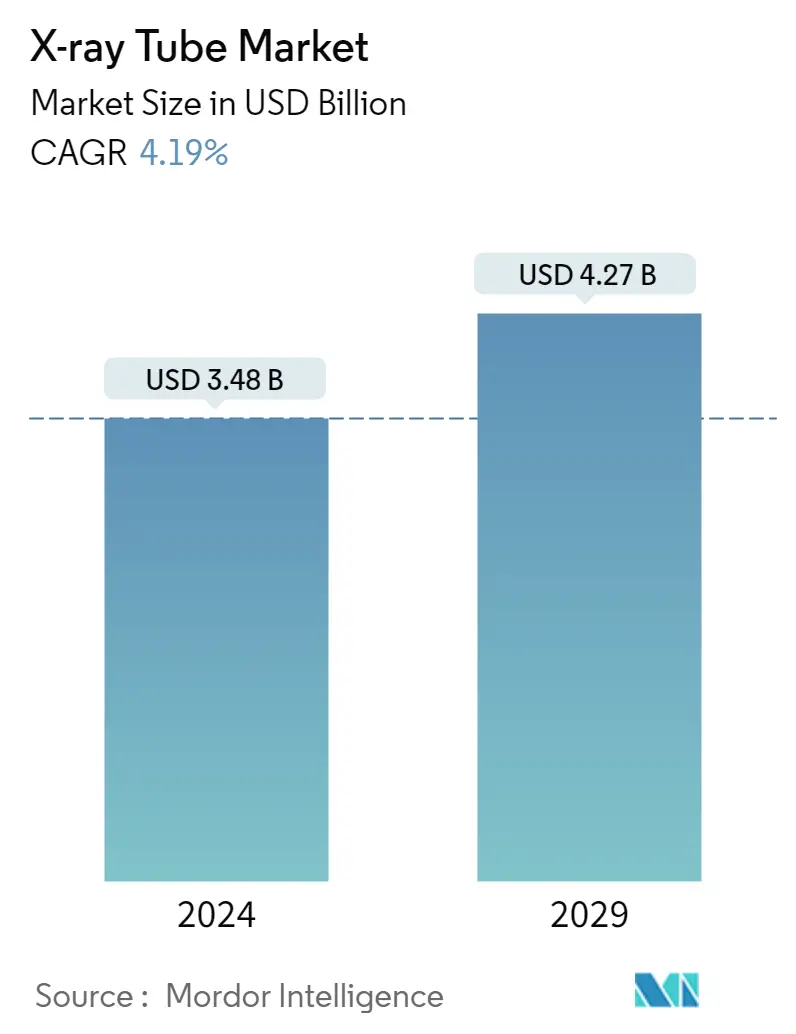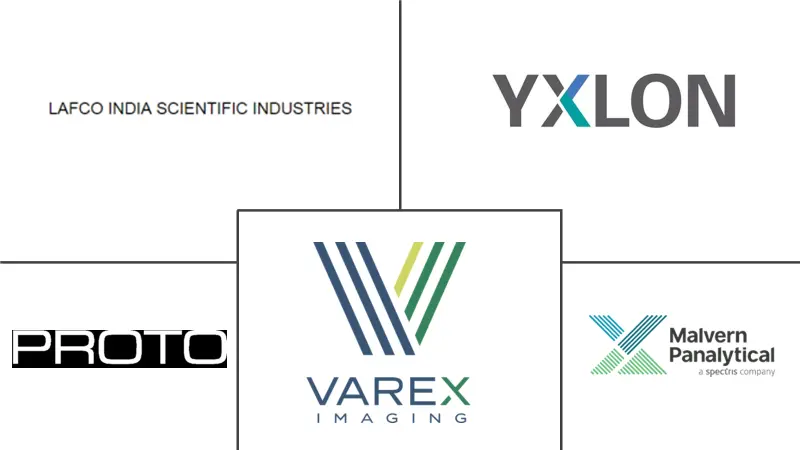Market Size of X-ray Tube Industry

| Study Period | 2019 - 2029 |
| Market Size (2024) | USD 3.48 Billion |
| Market Size (2029) | USD 4.27 Billion |
| CAGR (2024 - 2029) | 4.19 % |
| Fastest Growing Market | Asia-Pacific |
| Largest Market | North America |
| Market Concentration | Low |
Major Players
*Disclaimer: Major Players sorted in no particular order |
X-Ray Tube Market Analysis
The X-ray Tube Market size is estimated at USD 3.48 billion in 2024, and is expected to reach USD 4.27 billion by 2029, growing at a CAGR of 4.19% during the forecast period (2024-2029).
- X-rays have found applications in security, metallurgy, non-destructive testing, and other industrial applications. Technological advancement is one of the primary factors driving the growth of the market studied. Over the past few decades, the application of X-rays has drastically expanded beyond the field of medicine.
- With electronic innovations, these systems' sizes have significantly decreased. With the availability of compact systems, X-ray machines are now used in various fields, such as airport security, baggage scanning, and metallurgical applications. In addition, increasing medical cases and accidental injuries worldwide are influencing the growth of the market studied.
- For instance, recently, Excillum launched its latest development-a new generation of high-resolution X-ray tubes. The Excillum NanoTube N3, initially available in 3 different versions, enables the world's best resolution up to 160 kV. The NanoTube N3 targets advanced industries' metrology and non-destructive testing (NDT) components, e.g., automotive, aerospace, medical, electronics, and semiconductor back ends.
- The pandemic scenario benefited medical and healthcare applications greatly. Several associations and governing bodies have globally established CT and X-ray imaging as a primary mode of examination to check a patient for the presence of COVID-19-related symptoms. According to Siemens Healthineers, the studies conducted by multiple researchers found that the X-ray examinations had a lower sensitivity for COVID-19-related lung shadowing of 25% to 69%.
- In the near future, the high-demand regions, such as Asia-Pacific and North America, are expected to revise their safety regulations, leading to stricter rules and industrial standards. This scenario also makes it hard for new players to enter the market. Therefore, stringent regulations and validatory guidelines restrain the market's growth.
X-Ray Tube Industry Segmentation
An X-ray tube is a device that produces X-rays while subjected to an electric charge. The equipment consists of four parts: an anode, a cathode, a glass envelope, and a protective housing. The electrodes are placed in a vacuum-sealed glass envelope, and the charge is passed through the device. The electrons emitted at the electrode travel in a vacuum to reach the opposite electrode, thus resulting in the emission of X-rays. Since their inception, the tubes have found various applications in several industries, although the medical industry has been the primary consumer of these devices.
The X-ray Tube Market is segmented by type (rotating anode tube, stationary X-ray tube), end-user industry (manufacturing, healthcare, food, aerospace, and defense), and geography. The market sizes and forecasts are provided in terms of value (USD million) for all the above segments. The study also tracks key market parameters, underlying growth influencers, and major vendors operating in the industry, which supports the market estimations and growth rates during the forecast period. The study analyzes the impact of the COVID-19 pandemic on the ecosystem.
| Type | |
| Rotating Anode Tube | |
| Stationary X-Ray Tube |
| End-user Industry | |
| Manufacturing | |
| Healthcare | |
| Food | |
| Aerospace and Defense | |
| Other End-user Industries |
| Geography | ||||||
| ||||||
| ||||||
| ||||||
| Rest of the World |
X-ray Tube Market Size Summary
The X-ray tube market is poised for steady growth, driven by technological advancements and expanding applications across various sectors. Originally confined to medical use, X-ray technology has seen significant diversification, finding roles in security, metallurgy, and non-destructive testing. The miniaturization of electronic components has led to the development of compact X-ray systems, which are now integral to airport security and baggage scanning, among other industrial applications. The medical sector, particularly, has benefited from these advancements, with increased demand for imaging and diagnostic tests fueled by a rising geriatric population and the prevalence of chronic diseases. Innovations in medical radiation equipment, such as those by Siemens, Philips, and GE Healthcare, have enhanced the quality of imaging while minimizing radiation exposure, further propelling market growth.
In addition to technological progress, the market is influenced by regulatory environments and competitive dynamics. Regions like Asia-Pacific and North America are expected to tighten safety regulations, which could pose challenges for new entrants. However, established players continue to innovate, as seen with companies like Fortress Technology and Aidoc, who are expanding their product offerings and integrating advanced technologies. The market is also witnessing strategic acquisitions, such as Canon Medical's acquisition of Nordisk R√∏ntgen Teknik, aimed at enhancing technological capabilities and market reach. These developments underscore the competitive nature of the industry, where innovation and strategic partnerships are key to maintaining a competitive edge.
X-ray Tube Market Size - Table of Contents
-
1. MARKET INSIGHTS
-
1.1 Market Overview
-
1.2 Industry Value Chain Analysis
-
1.3 Industry Attractiveness - Porter's Five Forces Analysis
-
1.3.1 Bargaining Power of Suppliers
-
1.3.2 Bargaining Power of Consumers
-
1.3.3 Threat of New Entrants
-
1.3.4 Threat of Substitutes
-
1.3.5 Intensity of Competitive Rivalry
-
-
1.4 Technology Snapshot
-
1.4.1 Introduction
-
1.4.2 Major Components of X-ray Tube
-
1.4.2.1 Envelope
-
1.4.2.2 Cathode
-
1.4.2.3 Anode
-
1.4.2.4 Protective housing
-
-
-
-
2. MARKET SEGMENTATION
-
2.1 Type
-
2.1.1 Rotating Anode Tube
-
2.1.2 Stationary X-Ray Tube
-
-
2.2 End-user Industry
-
2.2.1 Manufacturing
-
2.2.2 Healthcare
-
2.2.3 Food
-
2.2.4 Aerospace and Defense
-
2.2.5 Other End-user Industries
-
-
2.3 Geography
-
2.3.1 North America
-
2.3.1.1 United States
-
2.3.1.2 Canada
-
-
2.3.2 Europe
-
2.3.2.1 United Kingdom
-
2.3.2.2 Germany
-
2.3.2.3 France
-
2.3.2.4 Rest of Europe
-
-
2.3.3 Asia-Pacific
-
2.3.3.1 China
-
2.3.3.2 Japan
-
2.3.3.3 India
-
2.3.3.4 Rest of Asia-Pacific
-
-
2.3.4 Rest of the World
-
-
X-ray Tube Market Size FAQs
How big is the X-ray Tube Market?
The X-ray Tube Market size is expected to reach USD 3.48 billion in 2024 and grow at a CAGR of 4.19% to reach USD 4.27 billion by 2029.
What is the current X-ray Tube Market size?
In 2024, the X-ray Tube Market size is expected to reach USD 3.48 billion.

